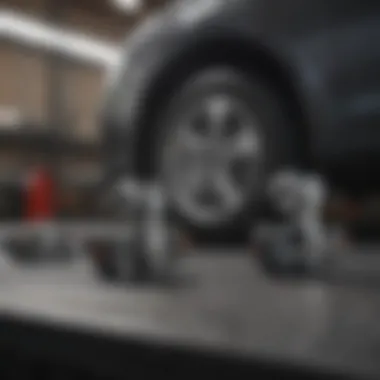Financial Aspects of Vehicle Alignment Explained


Intro
Vehicle alignment, an often-overlooked facet of vehicle maintenance, can have significant financial implications for car owners. Understanding the intricacies involved in alignment not only enhances the longevity of a vehicle but also saves money in the long run. If you have ever noticed uneven tire wear or your car pulling to one side, you might have experienced the consequences of poor alignment.
Many car enthusiasts and potential buyers are becoming more aware that the state of vehicle alignment directly affects performance, safety, and even fuel efficiency. Regular checks can mean the difference between a smooth ride and costly repairs. With the automotive market evolving, recognizing the current trends can also lead to better financial decisions concerning your vehicle.
When it comes to alignment, there’s a breadth of factors to consider, from basic maintenance schedules to the more profound impacts on overall vehicle health and expenses. In this article, we will delve into these topics, equipping readers with the knowledge to make informed decisions about vehicle alignment that will pay off in the long term.
Prelims to Vehicle Alignment
Understanding vehicle alignment is crucial for anyone who owns a vehicle, whether it's a tiny hatchback, a lumbering SUV, or a specialized truck. It’s not just about the mechanics; it’s about how the vehicle performs, how long its components last, and ultimately, how much money you’ll need to spend in repair and maintenance. When all parts of a vehicle are aligned properly, everything works harmoniously, leading to better handling and improved safety. Yet many drivers overlook alignment until they notice complications.
Vehicle alignment refers to the arrangement of a vehicle's wheels concerning each other and the road. Now, you might ask: why does that matter? Think about it. When wheels are aligned correctly, they’ll wear evenly and make contact with the road surface in the way intended by the manufacturer. This not only maximizes traction, but it also means fewer stops at the mechanic, safeguarding both your wallet and your car.
Key Points to Consider:
- Performance Enhancements: Well-aligned wheels lead to improved steering response, making driving experience smoother.
- Safety Benefits: Proper alignment contributes to better braking ability and control, which can prevent accidents.
- Cost Savings: Keeping an eye on alignment can save you money on fuel consumption due to enhanced efficiency and preventing premature tire wear.
This introduction sets the stage for a deeper dive into vehicle alignment metrics, costs, and its overarching importance in vehicle performance and financial health.
Understanding the Costs Involved
When it comes to maintaining a vehicle, understanding the costs involved in vehicle alignment is crucial. Many people tend to overlook this aspect of automotive upkeep, thinking it is just another expense. But the reality is that proper alignment can save you a fortune down the road by preventing more serious issues, like uneven tire wear and suspension problems. In essence, the financial implications of vehicle alignment can stretch beyond just the immediate costs associated with the service.
Consider that a well-aligned vehicle not only drives smoother but also optimizes fuel efficiency. You might find yourself filling up the tank less often – that’s money back in your pocket. This section will provide a detailed examination of the average costs associated with alignment services and explore key factors affecting those costs.
Average Costs for Vehicle Alignment
The price for vehicle alignment services can vary widely, but generally, you can expect to shell out anywhere from $50 to $100 for a two-wheel alignment, and $100 to $200 for a four-wheel alignment. This fluctuation in pricing can depend on a multitude of factors including your location and the service provider itself.
It’s worth noting that while these costs may seem steep, the payoff comes in the form of longer-lasting tires and better fuel economy – ultimately, a cost-effective choice when viewed over time. As most manufacturers recommend checking alignment every 6,000 miles or so, this maintenance service should be considered a small investment for peace of mind.
Factors Affecting the Price of Alignment Services
Understanding the price you might pay for alignment services involves a closer look into specific elements that contribute to those costs. Three major factors stand out:
Type of Vehicle


The type of vehicle you own plays an important role in determining alignment costs. For instance, larger vehicles like SUVs or trucks typically require more labor-intensive adjustments than compact cars. The key characteristic here is the vehicle’s size and weight, influencing not only the tools required for alignment but also the time taken by the technician.
For a compact car, a standard two-wheel alignment may be a straightforward fix. However, in the case of a heavy-duty pickup, more adjustments may be necessary, turning a simple job into a more complex one. As a general rule, the more complicated the vehicle’s suspension system, the higher the alignment service price spray you can expect.
Geographic Location
Your geographic location can dramatically affect alignment costs too. Cities often have a range of alignment services, with pricing that can be influenced by local demand and competition. Urban areas might see higher prices due to the cost of living and less competition. On the flip side, rural areas could offer lower costs but with possibly less experienced service providers. Each location brings unique advantages and challenges, so be sure to explore prices across different shops in your area to find the best deal.
Another consideration is local weather conditions. Areas with heavy snowfall and associated road damage might see more demand for alignment services, which can drive up the prices even further.
Service Provider Reputation
The reputation of the service provider is also a vital factor influencing prices. Well-known chains may charge higher rates due to their established trust and possibly greater experience. Conversely, a lesser-known garage might offer the services at potentially lower costs. Yet, this can come with its own risks. A reputable provider usually has a proven track record, which means they might diagnose issues more accurately and provide better service quality.
In the realm of vehicle maintenance, it’s always wise to balance cost against quality. It’s often better to pay a little more for someone who knows their stuff rather than risk poor workmanship from an inexperienced technician.
To summarize, while vehicle alignment may seem like an overlooked expense, understanding its costs can reveal deeper financial implications that encourage regular maintenance.
Types of Alignment Services
Understanding the different types of alignment services is crucial for maintaining vehicle performance and optimizing financial outcomes. Each type serves unique purposes and varying vehicle requirements, impacting both the alignment cost and long-term health of your vehicle. Exploring this realm sheds light on how to choose the alignment service that best suits your vehicle and your wallet.
Two-Wheel Alignment
Two-wheel alignment, often referred to as front-end alignment, is primarily intended for vehicles with a rear axle that’s stationary or equipped with a solid axle. This service focuses on adjusting the front wheels to ensure they are in alignment with each other and the rear wheels. Here are core aspects to consider:
- Cost-Effective: Generally, this service is less expensive than four-wheel alignment because it requires fewer adjustments.
- Suitability: Ideal for older models or vehicles that predominantly drive with the front wheels.
- Benefits:
- Improved Handling: Cars perform better and respond confidently, especially during turns.
- Tire Longevity: Reduced uneven tire wear leads to longer tire life.
It's essential, however, to recognize that while the upfront costs may be lower, this type of alignment might not be sufficient for all vehicles.
Four-Wheel Alignment
Four-wheel alignment encompasses a more intricate service that adjusts all four wheels of a vehicle. This service is particularly important for vehicles with independent rear suspensions and those that carry heavy loads or tow regularly. Factors to keep in mind include:
- Comprehensive Adjustment: It takes into account not just the front wheels, but also rear wheels, ensuring they all point in the same direction.
- Enhanced Stability: Vehicles benefit from steadier handling at higher speeds and improved traction. This translates to better safety on the road.
- Cost Assessment: Although more expensive than two-wheel alignment, the long-term savings from reduced tire wear can justify the expenditure.
"Investing in a four-wheel alignment can save on multiple tire replacements down the road."


Alignment for Specialized Vehicles
Specialized vehicles like trucks, vans, and high-performance sports cars often require tailored alignment services. These vehicles may have unique suspension systems, weight distributions, or usage specifications that demand meticulous adjustments. Here are some insights:
- Custom Solutions: Specialized alignment might include performance metrics, such as camber and caster adjustments, specifically tailored for the vehicle's purpose.
- Cost Consideration: Expect higher service fees due to the complexity of the alignment process and potential need for specialized equipment.
- Benefits:
- Enhanced Safety: Proper alignment in specialized vehicles not only promotes better handling but safeguards against unexpected issues.
- Performance Optimization: Leaning toward specialized service ensures the vehicle performs at its best, whether for off-road capabilities, heavy loads, or race conditions.
In summary, understanding the nuances of alignment services can help ensure your vehicle operates efficiently while keeping costs in check. Opting for the right type of alignment based on your vehicle's needs is pivotal for both performance and financial implications.
Importance of Regular Alignment Checks
The importance of regular alignment checks for vehicles cannot be understated. This task ensures that wheels are aligned with each other and the road, optimizing performance, safety, and functionality. Ignoring alignment can lead to a host of issues, which can significantly impact both driving experience and financial outlay.
Signs Indicating Misalignment
There are several telltale signs that suggest your vehicle is due for an alignment check. If your car pulls to one side while driving on a straight road, it’s like the universe is trying to nudge you into understanding something’s not right. You might also notice uneven tire wear, which is often a glaring indicator of misalignment. Imagine putting on a new pair of shoes only to find they wear out unevenly after just a few weeks; it’s frustrating and costly. Here are some key symptoms to watch for:
- Steering Wheel Tilt: If your steering wheel isn't perfectly centered when driving straight, it could suggest your wheels need some attention.
- Vibration or Shuddering: Unusual vibrations while steering at certain speeds often mean your alignment is off.
- Diminished Handling: A sudden loss of control, especially on curves, can be alarming and is often related to alignment faults.
Regular alignment checks can extend tire lifespan by up to 50%!
Neglecting these indicators can lead to severe consequences, ranging from altered handling to costly tire replacements.
Manufacturer Recommendations for Alignment Frequency
Most vehicle manufacturers provide specific guidelines regarding alignment checks. Typically, it's recommended to have your vehicle aligned at least once a year. However, if you frequently drive on rough roads or experience erratic handling, more frequent checks might be wise. Here are some general considerations:
- Post-Accident or Impact: Whenever there’s been a collision or even if you hit a sizable pothole, it’s prudent to have an alignment check.
- Tire Rotation: Many auto professionals suggest checking alignment during routine tire rotations, ensuring that you catch any misalignments before they cause significant wear.
- Mileage Marks: Taking a cue from your vehicle's recommended maintenance schedule, such as every 6,000 to 10,000 miles, can keep alignment issues at bay.
A clear alignment regimen will help protect not only your tires but also components like suspension and steering, ensuring optimal performance and longevity. This perceptiveness to your vehicle’s needs can translate into savings in both the short and long term, emphasizing that regular checks form a critical component in any vehicle maintenance strategy.
Long-Term Financial Considerations
When it comes to vehicle alignment, the long-term financial aspects are of utmost importance. Proper alignment contributes not just to immediate performance but also to the car’s longevity and overall ownership costs. Not addressing alignment issues can lead to an array of costly repair bills down the road, creating a cascade effect that hits a vehicle owner right in the wallet. This section analyzes how investing in routine alignment checks can save significant amounts of money over time, emphasizing the wisdom of preventative maintenance practices.
Cost-Benefit Analysis of Regular Alignments


Conducting regular alignments is not merely a procedure on a maintenance checklist; it is an investment in both time and resources that pays dividends in the long run. Think of it as oil changes for your tires and suspension. Regular alignments can help ensure that your vehicle operates at optimal performance while considerably extending the lifespan of components.
- Reduction in Tire Wear: Misalignment causes tires to wear unevenly, which means you might be buying new tires far sooner than you would if they were correctly aligned. The cost of a good set of tires is significant – the benefit of regular alignments is clear.
- Increased Fuel Efficiency: Cars not aligned properly tend to drag or pull, requiring more energy, which translates into greater fuel consumption. Regular checks can enhance fuel efficiency, allowing drivers to save money at the pump while being kind to the environment.
- Avoidance of Major Repairs: Ignoring minor alignment issues can result in expensive repairs to suspension or steering systems over time. By taking care of alignments regularly, you can prevent these larger issues from cropping up.
Overall, the long-term savings and benefits of maintaining vehicle alignment typically outweigh the costs of the service itself, making it a prudent financial decision.
Potential Costs of Ignoring Alignment
Failing to pay attention to vehicle alignment can spiral into a host of financial problems. It is crucial to understand potential costs associated with neglecting this key maintenance routine.
Tire Wear
When a vehicle is out of alignment, it can cause tires to wear more on one side than the other, leading to premature successor of tires—mesh that scenario with a driver trying to save a few bucks now rather than accelerating savings. Not only do the tires need replacing sooner, but driving on worn tires presents safety risks. The degraded performance can impact traction, making it more skittish in terms of handling and response. Timing of replacement can escalate this cost far beyond that of regular alignments.
Suspension Damage
Misaligned vehicles put undue stress on suspension components. Small alignment issues can elevate stress on shocks, struts, and other suspension parts, leading to greater wear and tear. Over time, you might find that you’re looking at hefty bills to replace or repair damaged suspension parts. It’s a nasty surprise that many drivers don’t anticipate and typically regret down the line.
Fuel Efficiency Loss
An ignored alignment can lead to the vehicle dragging or resisting motion, meaning it works harder to move even in straightforward conditions. This not only impacts performance but also results in increased fuel costs. A vehicle that consumes more fuel due to alignment issues acts against the principle of efficient driving. Over time, the cumulative cost from less efficient fuel consumption can end up being astronomical for anyone firing up the motor daily.
In summary, the financial implications of neglecting vehicle alignments can be severe and multifaceted. Each of these elements intertwines to create a broader picture that illustrates the clear necessity of regular alignment checks. Ignoring these warnings can negatively affect not only your wallet but also the overall driving experience, driving home the message that investing in vehicle alignment is both smart and necessary.
Epilogue
The topic of vehicle alignment is not merely a technical issue but also a financial one that carries significant weight in the realm of automotive maintenance. As we have seen through this exploration, proper alignment has far-reaching implications that extend beyond the immediate cash outlay for services. It impacts overall vehicle performance, affects the longevity of essential components, and can either bolster or hinder fuel efficiency. Beyond the direct costs associated with misalignment, the importance of understanding these dynamics can’t be overstated for both new and seasoned car owners.
Summarizing Key Insights
In summarizing the key points discussed throughout this article, it becomes clear that vehicle alignment is a pivotal element in maintaining a car’s health. The following insights crystallize this understanding:
- Financial Investment: Regular alignment checks represent a small investment compared to the potential costs of neglect. Ignoring these checks can lead to premature tire wear and expensive repairs on suspension or other related components.
- Performance Assessment: Proper alignment ensures the vehicle handles as intended, providing better steering precision which is critical for safety. A well-aligned vehicle is not only more enjoyable to drive but also reduces strain on various components.
- Environmental Considerations: By optimizing fuel efficiency through alignment, drivers also contribute to a decrease in harmful emissions, aligning with eco-conscious consumer behavior.
These points cogently encapsulate the financial implications tied to vehicle alignment and underline why this maintenance task deserves consideration.
Final Thoughts on Vehicle Maintenance
In concluding this article, it becomes evident that vehicle maintenance is not a chore to be brushed aside but a commitment to both safety and fiscal responsibility. Vehicle alignment is a cornerstone of that maintenance. Ensuring that your vehicle is properly aligned is akin to maintaining any crucial asset; it demands attention and diligence.
Automotive enthusiasts, fleet managers, and everyday drivers alike should prioritize regular alignment checks within their maintenance regimes. Not only does this safeguard the vehicle from potential malfunctions, but it also ensures that financial resources are utilized efficiently, ultimately leading to a superior driving experience.
"Investing in vehicle alignment is investing in peace of mind and financial prudence."
Staying attuned to the nuances of vehicle maintenance, especially regarding alignment, fosters a deeper understanding of automotive care, leaving drivers better informed and more capable of making sound decisions regarding their vehicle's upkeep. The bottom line is clear: a little attention to alignment can save a whole lot of trouble down the road.







